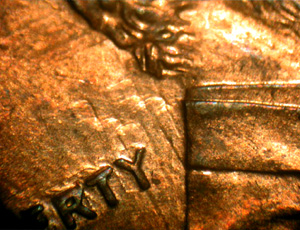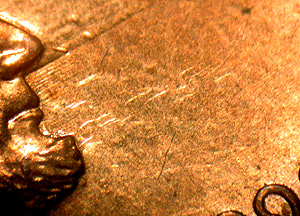Multiple Die Clashes
Dies can clash numerous times, but the multiple collisions will only be apparent when one of the dies (typically the hammer die) shifts position after each clash. This produces multiple, staggered clash marks. The distance between neighboring clash marks can be slight or marked. Lateral die movement after a clash naturally implies the development of a horizontal misalignment.
This 1998 cent shows a horizontal misalignment of the hammer die toward the northwest. It also shows a partial collar error. The coin preserves multiple, staggered clash marks that are best seen on the obverse face. These clash marks are arranged along a NW-SE transect. To create this pattern, the obverse die evidently moved incrementally toward the northwest after each clash.

